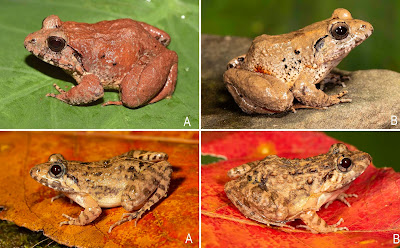__2022_Garg_Chandrakasan_Gokulakrishnan__@BijuSDas.jpg) |
| Minervarya charlesdarwini (Das, 1998), in Garg, Chandrakasan, Gokulakrishnan, ... et Biju, 2022. Charles Darwin’s minervaryan frog || DOI: 10.3897/vz.72.e79496 |
Abstract
Since the description of Charles Darwin’s frog as Rana charlesdarwini in 1998, its generic placement has been a taxonomic enigma. Subsequent studies first transferred this species to the dicroglossid genus Limnonectes, and then considered it as a ceratobatrachid of the genus Ingerana, which has since been moved to the family Dicroglossidae. However, recent works have doubted this generic placement and also suggested the possibility of its sister relationship with the genus Liurana, within Ceratobatrachidae. Nonetheless, there have been no detailed investigations to ascertain the generic placement of this taxon by confirming its phylogenetic position or using integrative taxonomic approaches. Here, we provide the first molecular assessment of Ingerana charlesdarwini based on mitochondrial and nuclear DNA and reveal that it is nested in the dicroglossid genus Minervarya. A member of the Minervarya andamanensis species group, Minervarya charlesdarwini comb. nov. is sister taxon to M. andamanensis and shows relatively shallow genetic distances (2.8–3.6%) in the 16S gene. Both species are widely distributed, occur sympatrically, and exhibit high morphological variations, leading to long-standing confusions with other dicroglossid frogs reported from the region. Our combined morphological and molecular studies on dicroglossid frogs sampled across the known ranges of these species suggest that reports of Limnonectes doriae (Boulenger, 1887) and L. hascheanus (Stoliczka, 1870) from the Andamans are misidentifications of the former two, pointing to the absence of genus Limnonectes from the Andaman Islands. Our study also reveals the novel record of Minervarya agricola from the Andamans, a species that appears to have been confused with Fejervarya limnocharis and Minervarya keralensis in the literature and misidentified museum specimens, and is found to be widely distributed across these islands. We further find another congener from the Nicobar group of Islands, M. nicobariensis, to be closely related to M. charlesdarwini. Similar to the case of Andaman dicroglossids, our work emphasises on the need for further studies to ascertain the taxonomic identities and generic placement of Minervarya and Limnonectes species reported from the Nicobars.
Key words: Amphibia, Ingerana, integrative taxonomy, island biogeography, Limnonectes, sympatric species
Minervarya charlesdarwini (Das, 1998), comb. nov.
Charles Darwin’s minervaryan frog
Distribution: Minervarya charlesdarwini is endemic to the Andaman Archipelago of India, where we find it to be widely distributed in all the major groups of islands: North and Middle Andamans (North Andaman Is., Interview Is., Middle Andaman Is., Baratang Is., and Long Is.), South Andamans (South Andaman Is., Neil Is., Havelock Is., Boat Is., Red Skin Is., Alexandra Is., Rutland Is., and Tarmugli Is.), up to the Little Andaman Island. This species has been observed between elevations of nearly sea level up to 600 m asl (Fig. 2; Table 2).
Minervarya andamanensis (Stoliczka, 1870)
Andamanese minervaryan frog
Distribution: Minervarya andamanensis is endemic to the Andaman Archipelago of India, where we find it to be widely distributed in all the major groups of islands: North and Middle Andamans (North Andaman Is., Landfall Is., East Is., Paget Is., Interview Is., Smith Is., Long Is., North Passage Is., North Reef Is., Baratang Is., and Middle Andaman Is.), South Andamans (South Andaman Is., Boat Is., Alexandra Is., Tarmugli Is., Rutland Is., Neil Is., and Havelock Is.), down to the Little Andaman Island. This species has been observed between elevations of sea level up to nearly 400 m asl (Fig. 2; Table 2).
Minervarya agricola (Jerdon, 1853) from Andaman Islands
Distribution. Minervarya agricola is a widely distributed species of South and Southeast Asia, being found in India, Sri Lanka, Bhutan, Nepal, Bangladesh, Myanmar, Thailand, and southern China (Garg and Biju 2021). In the Andaman Archipelago of India, we provide new reports of this species from all the major groups of islands: North and Middle Andamans (North Andaman Is., Baratang Is., and Middle Andaman Is.), South Andamans (South Andaman Is., Neil Is., and Havelock Is.), up to the Little Andaman Island. This species has been observed between elevations of sea level up to elevations of nearly 130 m asl (Fig. 2; Table 2).
Sonali Garg, Sivaperuman Chandrakasan, G. Gokulakrishnan, C. Gopika, Indraneil Das and S. D. Biju. 2022. The Curious Case of Charles Darwin’s Frog, Rana charlesdarwini Das, 1998: Phylogenetic Position and Generic Placement, with Taxonomic insights on Other Minervaryan Frogs (Dicroglossidae: Minervarya) in the Andaman and Nicobar Archipelago. Vertebrate Zoology. 72: 169-199. DOI: 10.3897/vz.72.e79496
__2022_Garg_Chandrakasan_Gokulakrishnan__@BijuSDas.jpg)
__2022_Garg_Chandrakasan_Gokulakrishnan__@BijuSDas.jpg)
__2022_Garg_Chandrakasan_Gokulakrishnan__@BijuSDas.jpg)


__2022_Garg_Chandrakasan_Gokulakrishnan___@BijuSDas.jpg)
__2022_Garg_Chandrakasan_Gokulakrishnan___@BijuSDas.jpg)
__2022_Garg_Chandrakasan_Gokulakrishnan___@BijuSDas.jpg)